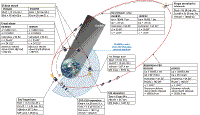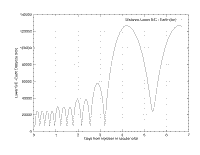Orbit/Navigation
Soyuz-Fregat Orbit
The Soyuz-Fregat launch vehicle comprises four stages. As the countdown clock reaches T-20 seconds, ignition of the first stage (the four strap-on boosters) and the second (core) stage takes place simultaneously. Over the next 20 seconds, the thrust builds up to maximum, when the rocket is released and begins to rise from the launch pad.
 |
|
Separation stages of launcher and |
The period of vertical flight lasts only 8 seconds - just long enough to safely clear the launch tower. The Soyuz then begins its long eastward ascent over Siberia, its progress monitored all the way by Russian tracking stations.
One minute 58 seconds after lift-off, the first stage boosters separate and fall away. On a clear day, this can be seen from the launch site on the Baikonur Cosmodrome.
The second stage continues to fire, propelling the booster to an altitude of about 170 km above the Earth. Meanwhile, at an altitude of about 100 km, after the Soyuz has passed through most of the atmosphere, the fairing that protects the Cluster spacecraft splits in half and is jettisoned. This takes place a little over 3 minutes into the flight.
One minute 40 seconds later, the second stage shuts down and is jettisoned. Almost immediately, the third stage ignites and continues to fire for four minutes, although the third stage aft section separates after about half a minute.
By the time the third stage shuts down, the Soyuz is about 1600 km downrange of the cosmodrome and flying on a ballistic trajectory at an altitude of approximately 220 km. The nose module (or upper composite) comprising the Fregat fourth stage and its pair of Cluster spacecraft separates from the third stage, and five seconds later the Fregat's first main engine burn begins.
The engine firing lasts for well over 3.5 minutes, propelling the upper composite into a circular low-Earth orbit. As it travels south east across the Pacific Ocean, the Fregat passes through a lengthy period of eclipse, when it is in the Earth's shadow.
 |
|
Soyuz-Fregat flight path (Starsem) |
The Fregat remains in a temporary circular orbit for just over one hour until its main engine is ignited for a second time. This burn, which takes place over Africa, continues for almost 10 minutes. It inserts the upper composite into a 251 × 18 038 km elliptical orbit, inclined at 64.9 degrees to the equator.
Finally, the Fregat begins a gentle roll to stabilise the Cluster satellites during their release. Its work completed, the upper stage is no longer required. 90 minutes after lift-off, the two Cluster spacecraft separate one at a time, from the Fregat. Soon after, their individual signals are received at the Kiruna ground station in Sweden. They are now ready to begin the complex series of manoeuvres that will carry them to their operational polar orbits.
The redundant Fregat is de-orbited and falls into the Atlantic Ocean to the east of South America some 6.5 hours after lift-off.
Self Propelled
Once released the two satellites used their own on-board propulsion systems to reach the final operational orbit. This involved changing their orbital inclination from 64.8° to 90°, while raising the highest point above the Earth (apogee) to 119 000 kilometres and the lowest point (perigee) of 19 000 kilometres.
 |
 |
|
Separation and orbit manoeuvres for Fregat and the Cluster pair |
Projection of Cluster pair on operational orbit plane |
To do this, each Cluster II spacecraft main engine performed six major manoeuvres. These orbital changes are made possible by the large amount of on-board fuel and oxidiser (245 kg MMH* + 405 kg NTO* = 650 kg), which makes up approximately half of each satellite's launch mass (1200 kg).
This nominal orbit is essentially inertially fixed, so that in the course of the mission it will enable a detailed examination of all significant regions of the Earth's magnetosphere.
 |
 |
|
Graphics showing the distance of the upper spacecraft (left) and lower spacecraft (right) from the Earth over the 7 days from injection in circular orbit. | |
* NTO = N2O4 = nitrogen tetroxide
MMH = monomethylhydrazine
Final Orbit
The orbit for each of the four Cluster spacecraft is selected so that each is located at a vertex of a predetermined tetrahedron when crossing the regions of interest within the magnetosphere. The separation distances between the spacecraft will be adjusted during the mission depending on the spatial scales of the structures to be studied and will vary from a few hundred kilometres to a few Earth radii. The separation manoeuvres will be performed at approximately six-month intervals, synchronised with normal orbit-maintenance manoeuvres.
 |
|
Artist's impression showing the main |
In orbit the four spacecraft will be spin-stabilised at all times. Their attitudes will be selected to ensure a solar-aspect angle of approximately 90°, which optimises the performance of the spacecraft's solar-power generator and thermal-control subsystem throughout the mission. This attitude will be maintained during manoeuvres in the operational phase of the mission, but it will be necessary to reorient the spacecraft temporarily during the orbit-transfer phase while certain specific manoeuvres are carried out.

